Vietnam, a country rich in history and culture, proudly possesses a treasure trove of intangible cultural heritages, honored and recognized worldwide by UNESCO. These heritages are not only symbols of national identity but also bridges between the past, present, and future, embodying the vibrant vitality and cultural essence of Vietnam’s diverse ethnic communities. Join “Du lịch khắp thế gian” to explore these precious gems and gain a deeper understanding of the Vietnamese soul and identity.
1. Via Ba Chua Xu Festival, Sam Mountain: A Unique Spiritual Cultural Heritage

The Via Ba Chua Xu Festival at Sam Mountain, recognized by UNESCO as an Intangible Cultural Heritage in 2024, is one of the largest and most important festivals in the Southern region of Vietnam. Held from the 22nd to the 27th day of the fourth lunar month at Ba Chua Xu Temple, Sam Mountain, Chau Doc, An Giang, the festival is a unique spiritual and cultural event, attracting millions of visitors annually.
The Via Ba Chua Xu Festival is not only an occasion for people to express their sincerity and gratitude to Ba Chua Xu – the goddess considered the protector of land and country – but also a place for cultural convergence and exchange among the Vietnamese, Cham, Khmer, and Hoa communities. Traditional rituals such as the procession of Ba Chua Xu’s statue, bathing the statue, building the stage, and performing classical drama (hat boi) are carried out solemnly, reenacting long-standing cultural and religious values. The festival is also a communal cultural space, hosting cultural and artistic activities, folk games, and showcasing the spirit of solidarity and community bonding.
2. Cham Pottery Art: Preserving the Essence of Traditional Craftsmanship
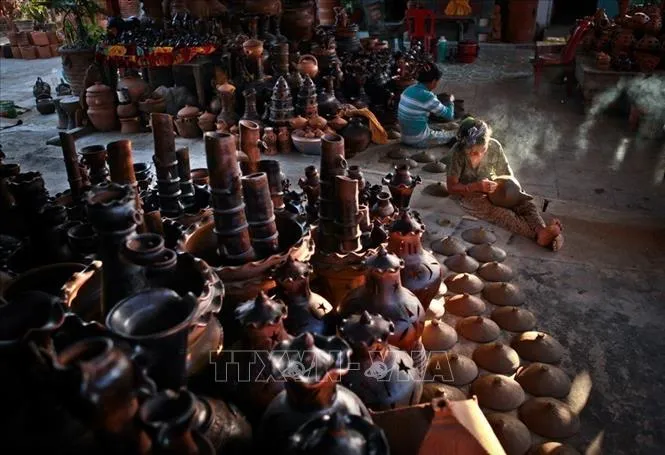
The Pottery Art of the Cham people in Bau Truc village, Ninh Thuan, inscribed by UNESCO on the List of Intangible Cultural Heritage in Need of Urgent Safeguarding in 2022, is a testament to the uniqueness and sophistication of Vietnamese traditional crafts. With a history dating back to the late 12th century, Bau Truc pottery is renowned not only for its unique outdoor firing technique but also for its creativity in shaping and decorative patterns, deeply rooted in Cham culture.
The handmade pottery process, from selecting clay, kneading, shaping, decorating patterns to firing, is entirely done by hand, reflecting the skill, meticulousness, and dedication of the artisans. Bau Truc pottery is not only a handicraft but also a living cultural heritage, reflecting the life, beliefs, and aesthetics of the Cham people. UNESCO’s recognition of Cham Pottery Art as an Intangible Cultural Heritage not only contributes to preserving and promoting the value of traditional pottery but also affirms Vietnam’s cultural position on the world map.
3. Xoe Thai Dance Art: A Dance Connecting Communities
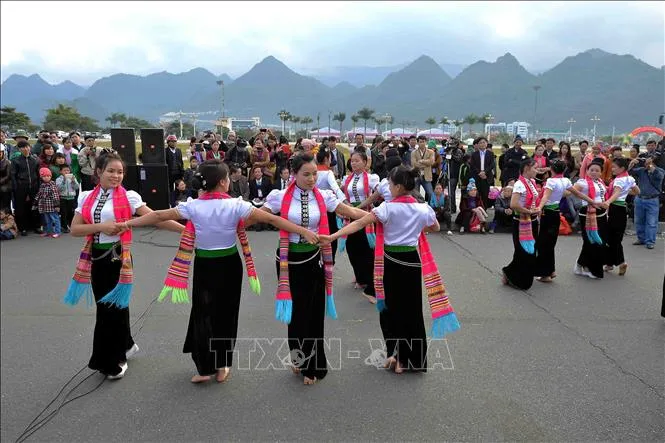
Xoe Thai Dance Art, honored by UNESCO as a Representative Intangible Cultural Heritage of Humanity in 2021, is a distinctive traditional dance of the Thai community in the Northwest region of Vietnam. Xoe Thai is not just a simple dance but also a cultural symbol, embodying the spirit of solidarity and community cohesion.
With six basic Xoe dances and many developed variations, Xoe Thai demonstrates the diversity and richness of Vietnamese folk dance art. Xoe Thai music often uses traditional instruments such as drums, gongs, and khen bè (bamboo panpipes), creating a vibrant and joyful musical space. Xoe dances are performed not only during festivals and traditional Tet holidays but also in daily life, expressing the joy, optimism, and aspirations for a prosperous and happy life of the Thai people.
4. Then Practice of the Tay, Nung, and Thai: Unique Spiritual Rituals
Then practice of the Tay, Nung, and Thai people, recognized by UNESCO as a Representative Intangible Cultural Heritage of Humanity in 2019, is an important religious ritual closely linked to the spiritual life of the Tay, Nung, and Thai communities in the Northern mountainous region of Vietnam. Then is not only a ritual for peace and healing but also a comprehensive folk performance art form, combining singing, music, dance, and theatrical elements.
Then practice reflects the Tay, Nung, and Thai people’s worldview, human life, and the relationship between humans and the natural world and supernatural forces. Then rituals are usually performed by Then priests, who are believed to be able to communicate with the spirit world. Then music uses instruments such as the tinh musical instrument, bells, and cymbals, creating a sacred and mystical atmosphere.
5. Bai Choi Art of Central Vietnam: Distinctive Folk Melodies
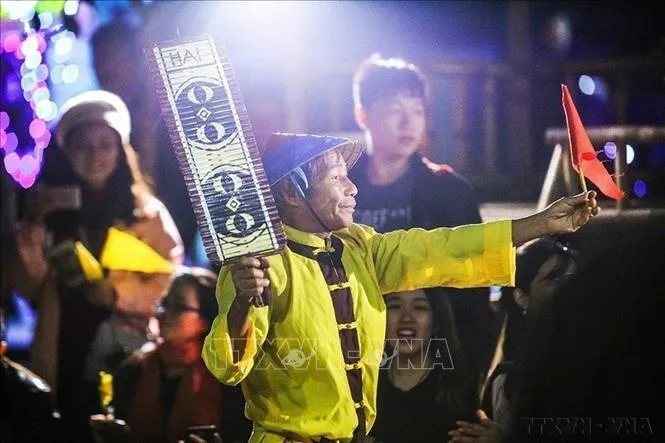
Bai Choi Art of Central Vietnam, inscribed by UNESCO as a Representative Intangible Cultural Heritage of Humanity in 2017, is a unique folk art form popular in the Central provinces of Vietnam. Bai Choi is both a lively folk game and a unique performance art, combining music, poetry, acting, painting, and literature.
Bai Choi originated from the need for communication and guarding on watchtowers in fields, later developing into a performance art form and entertainment game in the community. Bai Choi Art reflects creativity, improvisation, humor, and wit, reflecting the daily life and spiritual culture of the people of Central Vietnam.
6. Practices related to the Viet Belief in the Mother Goddesses of Three Realms: Unique Indigenous Beliefs
Practices related to the Viet Belief in the Mother Goddesses of Three Realms, recognized by UNESCO as a Representative Intangible Cultural Heritage of Humanity in 2016, is a unique indigenous belief with a long history, reflecting the rich spiritual life of the Vietnamese people. The belief in the Mother Goddesses of Three Realms worships goddesses who govern the heavens, earth, and water, expressing aspirations for a prosperous, happy, and peaceful life.
Practices related to the belief in the Mother Goddesses of Three Realms include rituals such as hau dong (spirit possession), festivals, and other religious cultural activities, demonstrating a harmonious combination of indigenous and foreign elements, creating a unique cultural identity. The belief in the Mother Goddesses of Three Realms is not only a spiritual cultural heritage but also an artistic cultural heritage, expressed through costumes, music, dance, rituals, etc.
7. Tug of war rituals and games: Martial Spirit and Community Bonding
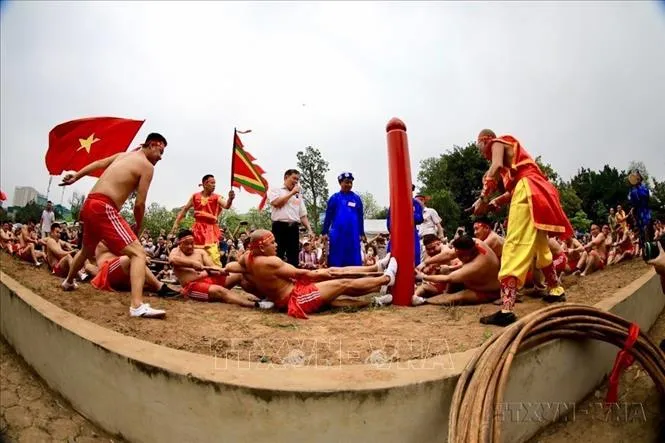
Tug of war rituals and games, honored by UNESCO as a Representative Intangible Cultural Heritage of Humanity in 2015, is a popular folk cultural activity in many East Asian countries, including Vietnam. Tug of war is not only a sport for physical training and martial spirit but also carries the meaning of praying for good harvests, expressing community cohesion.
In Vietnam, tug of war rituals and games are widely practiced in the midland, Red River Delta, and North Central Coast regions, closely associated with wet rice agriculture culture. Tug of war rituals are often organized during festivals and communal house festivals, expressing the spirit of solidarity, collective strength, and aspirations for a prosperous and happy life.
8. Vi and Giam Folk Songs of Nghe Tinh: Echoes of Homeland
Vi and Giam folk songs of Nghe Tinh, recognized by UNESCO as a Representative Intangible Cultural Heritage of Humanity in 2014, are two distinctive types of unaccompanied folk songs, created and passed down by the communities of Nghe An and Ha Tinh provinces. Vi and Giam folk songs are closely tied to the working and living life of the people of Nghe land, expressing their thoughts, feelings, and aspirations.
Vi and Giam folk songs have many rich and diverse melodies, used in various contexts, from labor production, daily life to festivals and weddings. Vi and Giam folk songs are not only a musical cultural heritage but also a linguistic and literary cultural heritage, reflecting the unique cultural identity of the Nghe Tinh region.
9. Southern Vietnamese Don Ca Tai Tu Music and Song: Folk Chamber Music
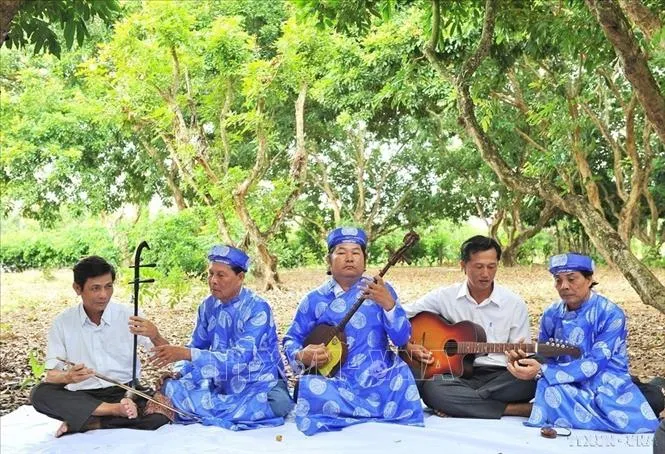
Southern Vietnamese Don Ca Tai Tu Music and Song, honored by UNESCO as a Representative Intangible Cultural Heritage of Humanity in 2013, is a distinctive folk art form of Southern Vietnam. Don Ca Tai Tu originated and developed from the late 19th century, based on ceremonial music, Hue royal court music, and folk literature.
Don Ca Tai Tu is a delicate combination of music and singing, expressing improvisation and transformation according to the performer’s emotions. Don Ca Tai Tu uses instruments such as the kìm (two-stringed lute), cò (vertical violin), tranh (16-string zither), bầu (monochord zither), and flute, creating a melodious and lyrical musical space. Don Ca Tai Tu is not only a musical cultural heritage but also a social cultural heritage, expressing community spirit and cultural exchange.
10. Worship of Hung Kings Belief in Phu Tho: Roots of the Nation
Worship of Hung Kings Belief in Phu Tho, recognized by UNESCO as a Representative Intangible Cultural Heritage of Humanity in 2012, is a traditional belief with sacred meaning in the spiritual life of the Vietnamese people. The worship of Hung Kings expresses gratitude and respect for the Hung Kings, the ancestors of the Vietnamese nation.
The Hung Kings Temple Festival, held on the 10th day of the third lunar month annually at the Hung Kings Temple Historical Site, Phu Tho, is the most typical manifestation of the Worship of Hung Kings Belief. The festival is an occasion for people nationwide to look towards their roots, express gratitude to their ancestors, and affirm the spirit of solidarity and national cultural identity.
11. Phu Tho Xoan Singing Art: Echoes of Ancient Festivals
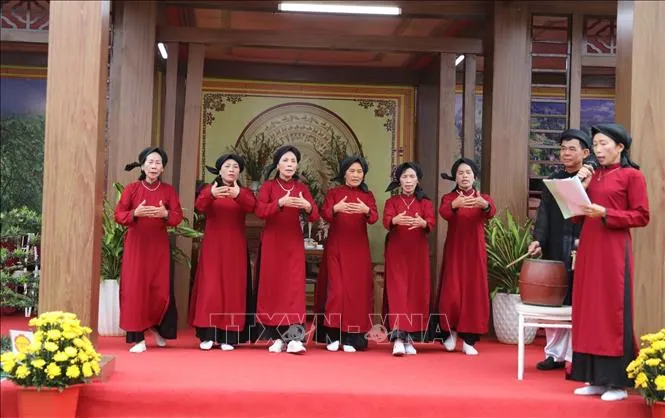
Phu Tho Xoan Singing Art, initially inscribed by UNESCO on the List of Intangible Cultural Heritage in Need of Urgent Safeguarding in 2011, then moved to the Representative List of the Intangible Cultural Heritage of Humanity in 2017, is a type of ritual singing art, associated with the worship of Hung Kings and deities. Xoan singing originated from the form of singing to worship the Hung Kings, a unique cultural activity of the people of Phu Tho.
Xoan singing includes ritual singing, quả cách singing (alternating), and giao duyên singing (love duets), demonstrating the combination of music, dance, and performance. Xoan singing is not only an artistic cultural heritage but also a historical and religious cultural heritage, reflecting the unique cultural identity of the ancestral land.
12. Giong Festival at Phu Dong and Soc Temples: Recreating the Legend of Saint Giong
Giong Festival at Phu Dong and Soc Temples, Hanoi, recognized by UNESCO as a Representative Intangible Cultural Heritage of Humanity in 2010, is a traditional festival, recreating the legend of Saint Giong, a hero who contributed to driving away foreign invaders and protecting the country. The Giong Festival is not only a religious festival but also a community cultural activity, expressing the patriotism and martial spirit of the Vietnamese people.
The Giong Festival takes place at two main locations: Phu Dong Temple (where Saint Giong was born) and Soc Temple (where Saint Giong ascended to heaven), with unique rituals and folk games, recreating the heroic battles of Saint Giong. The Giong Festival is a historical, religious, and artistic cultural heritage, reflecting the unique cultural identity of Thang Long – Hanoi land.
13. Ca Tru Singing Art: Sounds of Heritage
Ca Tru Singing Art, inscribed by UNESCO on the List of Intangible Cultural Heritage in Need of Urgent Safeguarding in 2009, is a type of chamber vocal music art, holding a special position in the treasury of Vietnamese traditional music. Ca Tru is associated with festivals, customs, beliefs, literature, thoughts, and philosophies of life of the Vietnamese people.
Ca Tru is a delicate combination of singing, đáy lute, and phách (wooden percussion), creating a solemn and refined musical space. Ca Tru has many genres and performance styles, showing diversity and richness in Vietnamese traditional music art. Ca Tru is not only a musical cultural heritage but also a literary and performing arts cultural heritage, reflecting the unique cultural identity of the Vietnamese nation.
14. Quan Ho Bac Ninh Folk Songs: Love Duet Songs

Quan Ho Bac Ninh Folk Songs, recognized by UNESCO as a Representative Intangible Cultural Heritage of Humanity in 2009, is a distinctive folk song genre of the Northern Delta region, mainly concentrated in the Kinh Bac region (Bac Ninh and Bac Giang). Quan Ho is a form of call-and-response singing between men and women, expressing love, friendship, and human affection through simple and heartfelt lyrics.
Quan Ho is practiced in cultural and social activities of the community, becoming a local cultural identity and spreading into a unique cultural space. Quan Ho is not only a musical cultural heritage but also a social cultural heritage, expressing community spirit and cultural exchange.
15. Space of Gong Culture in the Central Highlands: Echoes of Mountains and Forests
Space of Gong Culture in the Central Highlands, recognized by UNESCO as a Masterpiece of the Oral and Intangible Heritage of Humanity in 2005, spreads across five provinces: Kon Tum, Gia Lai, Dak Lak, Dak Nong, and Lam Dong. Gongs are closely associated with the life of the people of the Central Highlands, an indispensable part throughout each person’s life and in almost all important community events.
Gong music of the Central Highlands expresses the worldview, human life, and the relationship between humans and the natural world and supernatural forces of the people of the Central Highlands. The Space of Gong Culture in the Central Highlands is not only a musical cultural heritage but also a social and religious cultural heritage, reflecting the unique cultural identity of the Central Highlands region.
16. Hue Royal Court Music (Nha Nhac): Academic Music

Hue Royal Court Music (Nha Nhac), recognized by UNESCO as a Masterpiece of the Oral and Intangible Heritage of Humanity in 2003, is court music from the feudal era, performed during court assemblies, sacrifices, or important events. Hue Royal Court Music flourished and reached its most complete level during the Nguyen Dynasty, demonstrating sophistication and academic rigor in Vietnamese royal court music art.
Hue Royal Court Music is not only a musical cultural heritage but also a historical and performing arts cultural heritage, reflecting the unique cultural identity of Hue Imperial City and the Nguyen Dynasty.
Conclusion
UNESCO’s intangible cultural heritages in Vietnam are invaluable treasures, reflecting the diversity, richness, and uniqueness of Vietnamese culture. Exploring and learning about these heritages not only helps us understand more deeply about the history and culture of the nation but also contributes to preserving and promoting precious traditional cultural values for future generations. Let’s join “Du lịch khắp thế gian” to preserve and spread these unique cultural heritages to international friends, so that the beauty of Vietnamese culture shines brightly on the world map.